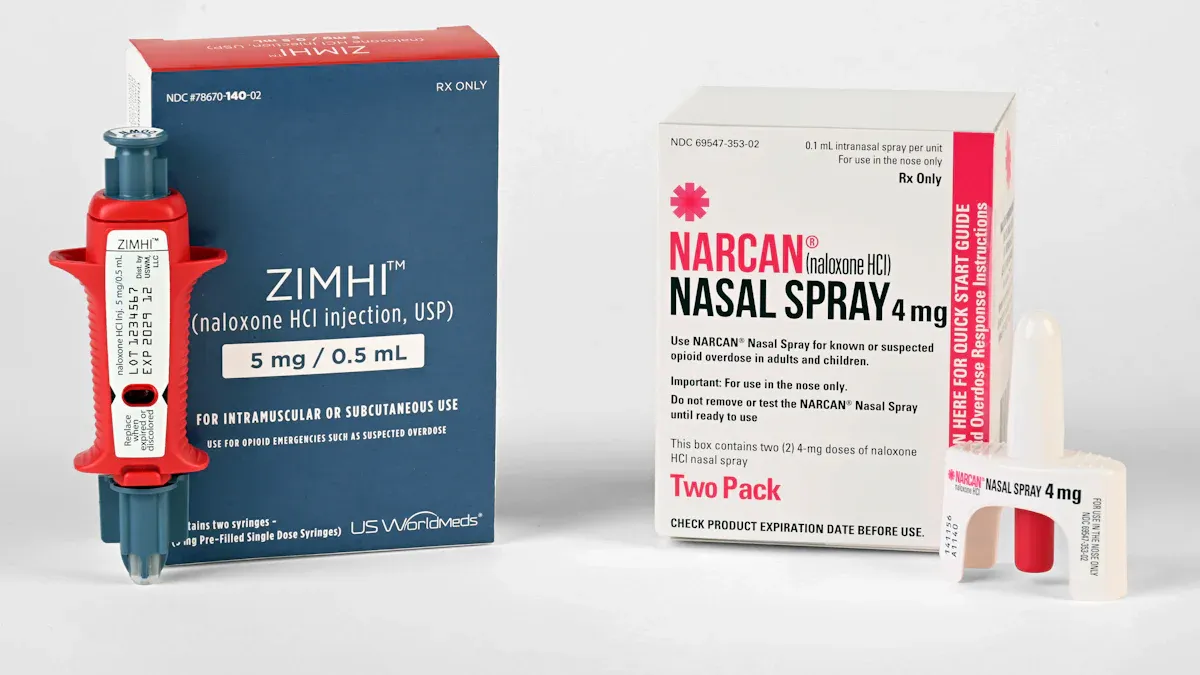
10 Essential Retatrutide Safety Tips for New Users

Disclaimer: This content is for educational and informational purposes only.
Using retatrutide safely is crucial for everyone. I know many people worry about potential side effects and risks. I want you to feel confident in your choice. It's essential to stay informed and monitor your health while using this medication. By being proactive, you can enjoy the benefits of retatrutide without unnecessary anxiety.
Key Takeaways
- Start with a small dose of retatrutide. This helps lessen stomach problems. Slowly increase the dose so your body can adjust well.
- Watch your symptoms carefully. Write down your daily feelings. This helps you talk better with your doctor about side effects.
- Be open to changing your dosing times. If you feel bad, think about not increasing the dose. This keeps your treatment plan easy.
- Learn about possible side effects. Know when to get medical help. Being aware can help you take care of your health better.
- Always listen to your doctor’s advice. Changing doses on your own can cause issues. Follow their suggestions for safe use.
Overview of Retatrutide Safety
When I think about the safety of retatrutide, I focus on the data from clinical trials. Understanding the risks helps me make informed decisions. Here’s what I found:
- The most common side effects of retatrutide are gastrointestinal issues. These include:
- Nausea
- Diarrhea
- Vomiting
These side effects are usually mild to moderate and often depend on the dose. I learned that starting with smaller doses can help reduce these gastrointestinal issues. This approach allows my body to adjust gradually.
Interestingly, some participants in studies experienced increases in heart rate. This increase was dose-dependent and peaked around 24 weeks. After that, it stabilized. This information reassures me that while there may be initial side effects, they can lessen over time.
In comparison to other medications, retatrutide shows a similar safety profile. For instance, semaglutide also has gastrointestinal side effects like nausea and vomiting. However, it has rare concerns about thyroid tumors and pancreatitis. On the other hand, tirzepatide has a higher risk of adverse events. This makes me appreciate the importance of monitoring my health while using retatrutide.
A systematic review of four randomized controlled trials confirmed that while gastrointestinal side effects are common, the overall safety profile of retatrutide is comparable to control groups. This gives me confidence in its use.
Common Side Effects of Retatrutide

When I started using retatrutide, I wanted to be aware of the common side effects. Understanding these effects helps me manage my expectations and stay prepared. Here’s what I discovered about the side effects I might encounter:
| Common Side Effects | Description |
|---|---|
| Nausea | A common gastrointestinal issue reported by users. |
| Vomiting | Another frequent side effect related to gastrointestinal discomfort. |
| Loose stools or diarrhea | Often experienced by users, particularly during the initial treatment phase. |
| Constipation | Some users report this as a side effect, indicating varied gastrointestinal responses. |
| Stomach cramping | A gastrointestinal symptom that may occur, especially during dose increases. |
| Skin Sensitivity | Mild reactions such as increased sensitivity or discomfort in certain areas. |
| Injection site irritation | Occasional mild redness, swelling, or itching at the injection site. |
From my research, I learned that gastrointestinal issues like nausea, vomiting, and diarrhea are quite common. In fact, many users experience these effects, especially when they first start treatment. I found it helpful to know that these side effects often lessen over time as my body adjusts to the medication.
Interestingly, the severity of these side effects can vary. Most gastrointestinal effects are mild to moderate, but I should remain vigilant. Serious adverse events occur in about 4% of users, which is a statistic I take seriously.
I also came across some important insights regarding dosage. Higher doses of retatrutide can lead to an increased risk of gastrointestinal-related side effects. This information reassures me that starting with a lower dose can help minimize discomfort.
Tips for Safe Use of Retatrutide

Using retatrutide safely is essential for my health and well-being. Here are some tips I follow to ensure I use this medication effectively:
-
Start with a Low Dose: I began with a lower dose to minimize gastrointestinal side effects. Gradual dose increases help my body adjust without overwhelming it.
-
Monitor My Symptoms: I keep track of any side effects I experience. This helps me communicate effectively with my healthcare provider. If I notice anything unusual, I reach out for guidance.
-
Be Flexible with Dosing: Sometimes, I skip dose increases if I feel uncomfortable. This flexibility allows me to adhere to my treatment plan without unnecessary stress.
-
Follow Healthcare Provider Guidance: I always listen to my healthcare provider's instructions. Self-adjusting doses can lead to complications, so I stick to their recommendations.
When it comes to administering retatrutide, I follow these best practices:
- Read the Instructions: I make sure I understand the dosage and potential complications before self-injecting.
- Gather My Supplies: I ensure I have everything I need, including a self-inject pen and an alcohol swab.
- Choose My Injection Site: I prefer my stomach, upper thigh, or upper arm, and I rotate sites to avoid irritation.
- Clean the Injection Site: I use an alcohol swab and let it dry completely before injecting.
- Prepare the Self-Inject Pen: I attach a new needle and prime the pen to ensure it works properly.
- Administer the Injection: I pinch the skin, insert the needle at a 90-degree angle, and push the plunger down until it clicks.
- Hold the Needle in Place: I keep it in for six seconds to ensure the full dose is injected.
- Use a New Needle Each Time: This prevents infections and discomfort.
- Check the Flow: I ensure the pen dispenses medication correctly before use.
- Rotate Injection Sites: I avoid repeated injections in the same area to prevent lumps and irritation.
By following these tips, I feel more confident in my use of retatrutide. Staying informed and proactive helps me manage my health effectively.
Monitoring and Reporting Side Effects of Retatrutide
Monitoring my health while using retatrutide is essential. I take my side effects seriously and keep a close eye on how my body reacts. Here’s how I approach this important task:
-
Track My Symptoms: I maintain a daily log of any side effects I experience. This helps me identify patterns and communicate effectively with my healthcare provider. I note everything from nausea to skin sensitivity.
-
Know What to Expect: I learned that gastrointestinal issues are common. Serious adverse events affect about 4% of users, which includes both retatrutide and placebo groups. I stay informed about these statistics to understand what I might encounter.
-
Report Unusual Symptoms: If I notice anything out of the ordinary, I reach out to my healthcare provider immediately. For instance, skin sensitivity affects around 7% of retatrutide users, compared to just 1% in the placebo group. I want to ensure that I address any concerns promptly.
-
Adjust My Approach: If I experience increased side effects, I consider adjusting my dosage under my healthcare provider's guidance. Higher doses can lead to more frequent gastrointestinal issues, so I remain flexible with my treatment plan.
-
Stay Informed: I read up on the latest research and guidelines regarding retatrutide. This knowledge empowers me to make informed decisions about my health.
By actively monitoring and reporting my side effects, I feel more in control of my treatment. I encourage others to do the same. Staying proactive can lead to better health outcomes and a more positive experience with retatrutide.
When to Seek Medical Attention for Retatrutide
Using retatrutide can be a positive experience, but I must stay vigilant about my health. There are specific situations where seeking medical attention becomes crucial. Here’s what I keep in mind:
Seek immediate help if I experience any of the following: - Severe gastrointestinal symptoms like intense vomiting, persistent diarrhea, or severe stomach pain. - Symptoms of pancreatitis, which may include severe abdominal pain radiating to the back, fever, or vomiting. - Signs of allergic reactions, such as hives, difficulty breathing, or swelling of the face, lips, or throat. - Symptoms indicating thyroid concerns, like swelling in the neck or difficulty swallowing.
I also learned about certain criteria that indicate when I should consult my healthcare provider. For instance, if I have a Body Mass Index (BMI) of 27.0 kg/m² or higher, I should be cautious. Additionally, if I have established atherosclerotic cardiovascular disease (ASCVD) or chronic kidney disease (CKD), I need to monitor my symptoms closely.
Here’s a quick reference table that outlines the inclusion and exclusion criteria for retatrutide treatment:
| Criteria Type | Details |
|---|---|
| Inclusion Criteria | Participants may be without type 2 diabetes (T2D), or with T2D if HbA1c is 10% or lower. |
| Established atherosclerotic cardiovascular disease (ASCVD) and/or chronic kidney disease (CKD). | |
| Body Mass Index of ≥27.0 kg/m². | |
| Exclusion Criteria | Type 1 Diabetes or history of diabetic ketoacidosis. |
| Cardiovascular conditions ≤ 90 days prior to randomization (e.g., myocardial infarction). | |
| eGFR <20 mL/min/1.73 m² at screening. | |
| History of chronic or acute pancreatitis. |
By staying aware of these signs and criteria, I can take proactive steps to protect my health while using retatrutide. If I ever feel uncertain, I won’t hesitate to reach out to my healthcare provider. It’s better to be safe and ensure I’m on the right track.
In summary, I’ve learned that using retatrutide safely involves several key practices. I always start with a low dose, monitor my symptoms, and follow my healthcare provider's guidance. Staying informed empowers me to manage my health effectively.
Remember, being proactive is essential. I encourage you to keep learning about retatrutide and its effects. Always consult your healthcare professional for personalized advice. Together, we can navigate this journey toward better health! 🌟
